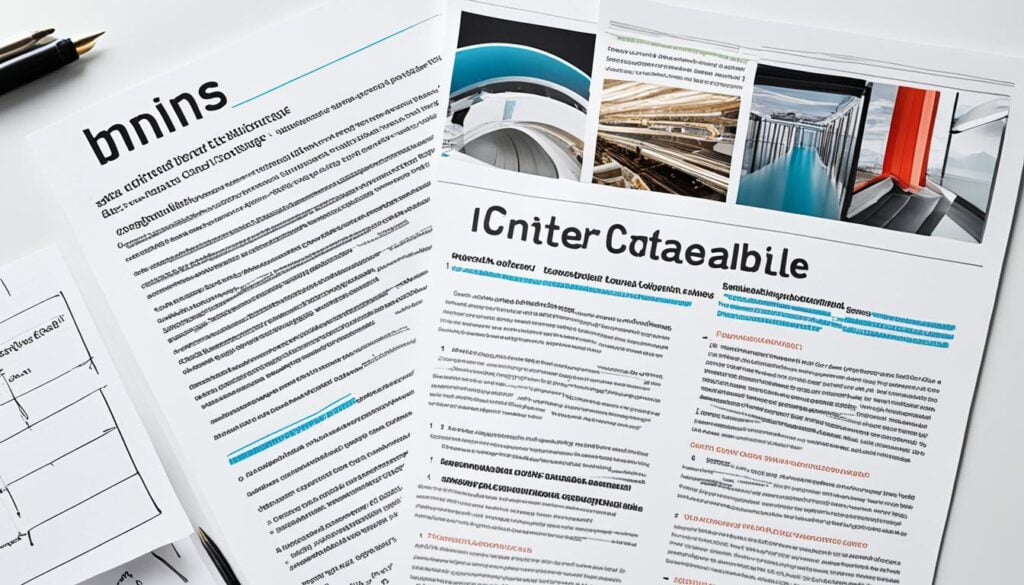Did you know that businesses that consistently publish blog posts experience a remarkable 350% increase in traffic compared to those that do not invest in content creation? In the current digital era, the creation of SEO-friendly articles has emerged as a pivotal element for enhancing organic traffic and elevating search engine rankings. Google’s affirmation that “content” is a paramount ranking factor underscores the significance of mastering the craft of writing SEO-optimized articles for your website’s visibility and success.
By adopting an SEO-centric content strategy, websites can potentially draw hundreds of thousands of search engine visitors each month. The writer’s site, for instance, attracts an impressive 449,058 search engine visitors monthly, a testament to their commitment to producing quality SEO content. But what precisely defines an article as SEO-friendly, and how can one optimize content to ascend in search results?
This exhaustive guide will explore the fundamental elements of crafting SEO-friendly articles, encompassing meticulous keyword research, compelling title creation, and content structuring for readability, alongside the incorporation of multimedia elements. You will discover the intricacies of seamlessly integrating target keywords, crafting engaging and informative content, and leveraging internal linking and external link building strategies to augment your article’s SEO efficacy.
Key Takeaways:
- Understanding the importance of SEO-friendly content and its impact on search engine rankings
- Conducting effective keyword research and selection to optimize your articles
- Crafting compelling titles and structuring your content for readability and SEO
- Focusing on user engagement and naturally integrating keywords throughout your article
- Enhancing your content with multimedia elements and optimizing them for search engines
- Leveraging internal linking and external link building strategies to improve SEO performance
Understanding the Importance Writing SEO-Friendly Articles
In the contemporary digital realm, the imperative for businesses and websites to cultivate SEO-friendly content is paramount. Such content not only captivates readers but also optimizes for pertinent keywords and phrases, thereby facilitating search engines’ comprehension and subsequent ranking of the content. This approach is fundamental to attracting organic traffic and enhancing search engine rankings.
Recent research by First Page Sage in 2024 underscores the significance of incorporating relevant keywords and optimizing content for search engines. This strategy can significantly improve website rankings. Moreover, the adoption of SEO-friendly writing practices is instrumental in driving organic traffic, with long-form content and comprehensive articles exhibiting superior performance.
The Role of Content in Search Engine Rankings
Search engines, notably Google, employ intricate algorithms to assess the relevance and quality of webpage content. By formulating content that is both informative and engaging, while also being optimized for relevant keywords, businesses can enhance their prospects of attaining higher positions on search engine results pages (SERPs). Such an approach is pivotal in augmenting the visibility and reach of online content.
| SERP Position | Click-Through Rate |
|---|---|
| 1 | 39.8% |
| 2 | 18.7% |
| 10 | 1.6% |
The table elucidates the correlation between SERP position and click-through rates, underscoring the critical role of SEO content in driving organic traffic. Websites positioned at the top of SERPs experience substantially higher click-through rates, highlighting the significance of SEO content in enhancing online visibility.
Benefits of Creating SEO-Optimized Articles
Engaging in the creation of SEO-optimized articles yields manifold benefits for businesses and websites, including:
- Increased visibility and organic traffic
- Improved search engine rankings
- Enhanced brand credibility and authority
- Targeted reach to potential customers
- Cost-effective marketing strategy
SEO acts as a bridge that helps search engine users reach your valuable content and get it noticed.
By prioritizing the development of high-caliber, SEO-friendly content, businesses can solidify their position as industry leaders, attract more qualified leads, and ultimately drive increased conversions and revenue.
Keyword Research and Selection
Keyword research is paramount in crafting SEO-optimized content. It entails identifying pertinent keywords and comprehending their search volume and competition levels. This knowledge enables the optimization of articles, enhancing their visibility on search engine results pages (SERPs) and subsequently driving increased organic traffic to the website.
Identifying Relevant Keywords for Your Topic
The initial step in keyword research involves pinpointing keywords pertinent to your topic and aligned with your audience’s search intent. Commence by brainstorming a list of potential keywords and phrases your audience might employ when seeking information related to your article’s subject. Utilize tools such as Google’s Keyword Planner, Ahrefs, or SEMrush to unearth additional keyword suggestions and evaluate their popularity.
When selecting keywords, aim for a harmonious balance between relevance and search volume. High search volume keywords, although appealing due to their popularity, often exhibit intense competition, rendering them challenging to rank for. Instead, concentrate on long-tail keywords that are more specific to your topic and exhibit lower competition levels.
Analyzing Keyword Search Volume and Competition
Post-identifying potential keywords, scrutinize their search volume and competition to ascertain their viability for your article. Search volume denotes the frequency with which a keyword is queried over a specified period, typically measured as monthly search volume (MSV). Elevated search volumes signify greater popularity and potential for organic traffic influx.
Competition, conversely, encapsulates the difficulty of ranking for a particular keyword. Keywords with high competition are frequently dominated by established websites boasting strong domain authority. To gauge keyword competition, consider the number of competing pages, the quality and relevance of the top-ranking pages, and the domain authority of the websites currently ranking for the keyword.
| Keyword | Monthly Search Volume | Competition |
|---|---|---|
| keyword research | 9,900 | High |
| relevant keywords | 1,600 | Medium |
| search volume | 6,600 | High |
| keyword competition | 1,300 | Medium |
| long-tail keywords | 2,900 | Low |
Incorporating Long-Tail Keywords
Long-tail keywords, characterized by their longer, more specific nature, often exhibit lower search volume but also lower competition levels. They tend to be more targeted, attracting a more qualified audience to your article. For instance, instead of targeting the broad keyword “content marketing,” focus on a long-tail keyword like “content marketing strategies for B2B startups.”
Integrate long-tail keywords into your article naturally, throughout your headlines, subheadings, and body text. Avoid the practice of keyword stuffing, which involves excessively repeating keywords to manipulate search rankings. Prioritize the creation of high-quality, informative content that delivers value to your readers.
By conducting meticulous keyword research and selecting relevant, low-competition keywords, you can optimize your articles for search engines and attract more organic traffic to your website.
Crafting Compelling and Engaging Titles
The title of your article is the initial point of contact for readers, often determining their decision to delve deeper into your content. Crafting titles that are both compelling and engaging is paramount for attracting readers and optimizing your article for search engines. A meticulously crafted title can significantly enhance click-through rates by up to 5x, positioning it as a pivotal element within your SEO strategy.
It is imperative to maintain titles that are concise and descriptive. Search engines typically display only the initial 50-60 characters of a title, necessitating that your primary keyword and essential information are positioned at the forefront. Research indicates that headlines falling within the 55-70 character range, inclusive of spaces, exhibit optimal performance.

Integrating numbers, lists, and questions within your titles can enhance their allure to readers. Titles adorned with numbers, such as “10 Tips for…” or “5 Ways to…”, capture attention through their promise of a structured and clear presentation. Conversely, titles framed as questions, like “How to…” or “What is…”, pique curiosity and resonate with the nuances of voice search queries.
A great headline is the key to capturing your audience’s attention and enticing them to read your content.
The strategic inclusion of emotionally charged power words within your titles can markedly influence click-through rates. Phrases such as “amazing,” “incredible,” or “unbelievable” elicit strong emotional responses and elevate engagement. Nevertheless, it is crucial to avoid overutilizing these words to prevent the perception of clickbait.
When optimizing titles for SEO, the placement of relevant keywords at the headline’s outset is essential. This facilitates search engines’ comprehension of your article’s core topic, thereby enhancing its visibility in search results. Furthermore, the analysis of competitors’ headlines can unveil inspiration and insights for crafting distinctive SEO titles that stand out.
| Title Optimization Technique | Effect on SEO and Engagement |
|---|---|
| Including numbers and lists | Attracts readers and improves click-through rates |
| Using power words | Evokes emotions and increases engagement |
| Incorporating questions | Sparks curiosity and aligns with voice search queries |
| Placing keywords at the beginning | Improves visibility in search results |
The ultimate aim is to forge titles that captivate readers while also being optimized for search engines. By amalgamating the aforementioned techniques and keeping your target audience in focus, you can craft titles that not only drive traffic but also enhance engagement and boost your article’s SEO performance.
Structuring Your Article for Readability and SEO
Formulating an article with a coherent structure is paramount for both readability and SEO. This approach ensures that your content is not only engaging for readers but also aligns with search engine optimization principles. A meticulously organized article facilitates a seamless reader experience and enhances search engine comprehension of your content’s core themes and subtopics. Such clarity is instrumental in improving your page’s indexing and ranking.

Using Headings and Subheadings Effectively
Headings and subheadings are indispensable in segmenting your content into digestible sections. They establish a visual hierarchy, guiding readers through your narrative and aiding them in locating specific information swiftly. Adopt the following strategies when utilizing headings:
- Employ H1 tags for the primary title and H2-H6 tags for subheadings
- Ensure headings are concise and descriptive
- Integrate relevant keywords naturally into headings
- Ensure headings accurately depict the content of each section
Optimizing Paragraph Length and Sentence Structure
Enhancing readability is crucial for maintaining visitor engagement. To this end, focus on crafting paragraphs that are approximately 100 words in length and sentences with no more than 20 words. This approach not only facilitates easier reading but also ensures optimal consumption on mobile devices, a critical factor in today’s digital landscape.
| Element | Recommended Length | Benefits |
|---|---|---|
| Paragraphs | Around 100 words | Improves scannability and readability |
| Sentences | Maximum 20 words | Enhances clarity and understanding |
Incorporating Bullet Points and Numbered Lists
Bullet points and numbered lists are invaluable for presenting information succinctly and attractively. They alleviate the monotony of extended text and accentuate pivotal points or steps. Employ bullet points to underscore key benefits, features, or advice, and utilize numbered lists for delineating a sequence of actions or ranking items by significance.
By structuring your article with clear headings, concise paragraphs, and engaging lists, you can create content that is both reader-friendly and optimized for search engines.
The ultimate aim is to furnish your readers with valuable insights while simultaneously ensuring that search engines can effortlessly comprehend and rank your content. By prioritizing readability and adopting a systematic article structure, you can fulfill both objectives, thereby driving traffic and engagement to your articles.
How to Write SEO Friendly Article
Creating SEO-friendly articles is paramount for enhancing your website’s visibility on search engines and drawing organic traffic. To craft content that resonates with both search engines and users, it is imperative to concentrate on several pivotal elements. These include readability, user engagement, the strategic integration of keywords, and the provision of valuable information.
Focusing on Readability and User Engagement
Ensuring your article’s readability and engagement with your target audience is a cornerstone of SEO-friendly content creation. This necessitates the utilization of clear, concise language, the fragmentation of text into manageable paragraphs, and the incorporation of subheadings to facilitate reader navigation. Such measures enhance readability, thereby augmenting user engagement and extending the time spent on your webpage, which can positively influence your search engine standing.

Recent analytics underscore the efficacy of incorporating headlines and sub-headers in making content more accessible and shareable. Furthermore, the preference for longer, more comprehensive content, exceeding 1,500 words, is evident, as it is deemed to offer substantial value to users, thereby garnering higher priority from Google.
Naturally Integrating Keywords and Synonyms
The strategic placement of keywords within your article is vital for SEO, yet it is equally important to avoid the pitfalls of keyword stuffing. Google’s algorithms are adept at discerning the contextual relevance and authenticity of your content, thus emphasizing the importance of integrating target keywords and their synonyms organically. This approach not only enhances your search engine rankings but also preserves the readability and quality of your content.
For identifying pertinent keywords and their synonyms, tools such as Google Keyword Planner or SEMrush are invaluable. These platforms offer insights into keyword search volume, competition, and related terms that can be seamlessly integrated into your article.
| SEO Factor | Impact on Rankings |
|---|---|
| Keyword usage in titles, headlines, and meta descriptions | High |
| Keyword density in main copy | Moderate |
| Keyword usage in image ALT tags | Moderate |
Providing Valuable and Informative Content
The essence of crafting SEO-friendly articles lies in the provision of content that is both valuable and informative, addressing the needs and interests of your target audience. By focusing on the creation of high-quality, engaging content that incorporates relevant keywords in a natural manner, you can significantly enhance your search engine rankings and attract more organic traffic to your website.
To ensure the informative and value of your content, consider the following strategies:
- Conduct exhaustive research on your topic to deliver accurate and current information
- Employ examples, case studies, and statistics to bolster your arguments and enhance content credibility
- Address prevalent questions and concerns related to your topic for comprehensive coverage
- Offer actionable advice and takeaways that readers can apply to solve their problems or achieve their objectives
High-quality and relevant content is a crucial factor in search engine rankings.
By prioritizing readability, user engagement, the strategic integration of keywords, and the provision of valuable content, you can create SEO-friendly articles that draw organic traffic and elevate your search engine rankings.
Optimizing Meta Tags and Descriptions
Meta tags and descriptions are pivotal in augmenting your article’s visibility and click-through rates within search engine results pages (SERPs). By meticulously optimizing your meta titles, meta descriptions, and integrating focus keywords, you can significantly enhance your content’s SEO performance. This, in turn, attracts more targeted traffic to your website.

Crafting Compelling Meta Titles and Descriptions
When devising meta titles, aim for a length between 50 and 60 characters to ensure they are fully displayed in SERPs without truncation. Incorporate action-oriented language and your primary keyword to make your title tag more captivating and pertinent to user searches. For meta descriptions, maintain them between 155-160 characters and compose unique, compelling descriptions that succinctly summarize your content while seamlessly integrating your focus keywords.
| Element | Optimal Length | Impact on SEO |
|---|---|---|
| Meta Title | 50-60 characters | Higher rankings for targeted queries |
| Meta Description | 155-160 characters | Increased click-through rates (CTR) |
A study of 5 million Google search results reveals that pages with a meta description garnered an average of 5.8% more clicks than pages without. This underscores the significance of crafting compelling meta descriptions to entice users to explore your content further.
Incorporating Focus Keywords in Meta Tags
When optimizing your meta tags, ensure the incorporation of your focus keywords in a natural manner. This facilitates search engines in comprehending the relevance of your content, potentially enhancing your page rankings for those targeted queries. Nevertheless, eschew overusing keywords or engaging in keyword stuffing, as this can detrimentally affect your SEO endeavors.
By strategically placing metadata within web page code, SEO efforts can be more effective.
To optimize your meta tags effectively, consider the following tips:
- Use unique meta titles and descriptions for each page to circumvent duplicate content issues
- Include your primary keyword in both the meta title and meta description
- Avoid misleading titles that do not accurately reflect your content, as this can escalate bounce rates
- Utilize Open Graph meta tags ( og: title, og :description, og:image) to augment social media visibility when your content is disseminated
By adhering to these best practices for optimizing meta tags and descriptions, you can significantly enhance your article’s SEO performance, elevate its visibility in search engine results, and drive more targeted traffic to your website.
Enhancing Your Article with Multimedia
Incorporating multimedia elements into your articles significantly enhances their SEO-friendliness and appeal to readers. By leveraging a variety of media formats, including images, videos, and infographics, you can create a more engaging and informative experience. This approach not only captivates your audience but also improves your search engine rankings.
Using Images, Videos, and Infographics
Visual content is paramount in capturing readers’ attention and breaking up text. When selecting images for your articles, prioritize high-quality, relevant visuals that complement your content. Videos excel in demonstrating complex concepts or providing tutorials, while infographics are perfect for presenting data or processes succinctly.
When integrating multimedia into your articles, adhere to the following best practices:
- Choose high-resolution images that load swiftly
- Optimize video length and ensure swift loading times
- Create informative and visually appealing infographics
- Use descriptive file names and alt tags for images
- Embed videos from reputable hosting platforms like YouTube or Vimeo
Optimizing Multimedia for Search Engines
To ensure your multimedia content enhances your SEO efforts, it’s crucial to optimize each element for search engines. This entails:
- Using descriptive, keyword-rich file names for images and videos
- Adding alt tags to images that accurately describe their content
- Including transcripts or closed captions for videos
- Compressing image and video files to improve page load times
- Hosting videos on your own domain when feasible
By employing these optimization techniques, you can facilitate search engines’ understanding and indexing of your multimedia content. This leads to improved visibility and higher rankings in search results.
| Multimedia Type | Ideal Use Cases | Optimization Tips |
|---|---|---|
| Images | Product showcases, visual examples, header images | Compress files, use descriptive file names and alt tags |
| Videos | Tutorials, product demos, interviews, webinars | Include transcripts, optimize titles and descriptions, host on reputable platforms |
| Infographics | Data visualization, process explanations, comparisons | Use clear and concise text, optimize for shareability, include embed codes |
A Google Quality Guidelines document told reviewers to consider pages with “supplementary content” (in the form of calculators, downloads, and diagrams) higher quality than text-only pages.
By strategically incorporating multimedia elements into your articles and optimizing them for search engines, you can create a more engaging and SEO-friendly experience. This approach drives more traffic and improves your online visibility.
Internal Linking and External Link Building
Internal linking and external link building are paramount in a successful SEO strategy. Internal linking entails linking one webpage to another within your site, whereas external link building involves securing links from external websites to your domain. These practices are integral for enhancing your website’s visibility, authority, and search engine rankings.
Internal links facilitate Google’s ability to discover, index, and comprehend your site’s pages. A meticulously structured internal link network guides search engine crawlers through your site, ensuring all pivotal pages are indexed. Moreover, internal linking enables the distribution of link equity from high-quality backlinks across your site.
Although links from external websites generally hold greater value, internal links still play a pivotal role in SEO. When constructing internal links, it is crucial to employ keyword-rich anchor text that contextualizes both for users and search engines. Strategically placing internal links at the outset of a page can diminish bounce rates and elevate dwell time by encouraging users to delve deeper into your content and explore related pages.
“Internal links aren’t just for SEO; they also help users navigate a website and discover related content.”
To refine your internal linking strategy, heed the following advice:
- Periodically review your internal links to ensure an equitable distribution and avoid overemphasizing certain pages
- Strategically link from your homepage to pages that necessitate heightened visibility
- Employ “dofollow” links for internal linking to facilitate the transfer of authority within your website
- Steer clear of uniform anchor text for diverse pages to prevent search engine confusion
- Integrate new content with internal links to high-authority pages to facilitate the rapid ascension of new pages in search rankings
Conversely, external link building entails procuring links from other esteemed websites. These links serve as endorsements from other sites, indicating to search engines the value and trustworthiness of your content. The accumulation of high-quality, pertinent backlinks augments your site’s chances of attaining superior search engine rankings.
| Internal Linking Benefits | External Link Building Benefits |
|---|---|
| Facilitates search engines in discovering and indexing pages | Augments website authority and credibility |
| Transfers link equity between pages | Drives referral traffic from other websites |
| Enhances user navigation and engagement | Introduces your brand to new audiences |
| Decreases bounce rates and elevates dwell time | Enhances search engine rankings for targeted keywords |
To cultivate a robust external link profile, concentrate on generating high-caliber, valuable content that naturally attracts links from other websites. Engage in outreach endeavors to promote your content to pertinent websites and industry influencers, and consider guest posting on reputable platforms to garner exposure and earn backlinks.
By adopting a comprehensive strategy that integrates both internal linking and external link building, you can significantly bolster your website’s SEO performance and drive more organic traffic to your site.
Conclusion
For content creators and marketers, the ability to craft SEO-friendly articles is paramount, serving as a cornerstone for enhancing search engine rankings and drawing in organic traffic. This guide has provided a comprehensive set of seo content writing tips, enabling you to produce content that not only captivates readers but also meets the stringent criteria of search engines.
Effective keyword research, the creation of compelling titles, and the meticulous structuring of articles for optimal readability are fundamental steps. Moreover, the seamless integration of keywords within your content, coupled with the optimization of meta tags, the incorporation of multimedia, and the strategic placement of internal and external links, can significantly bolster your article’s SEO efficacy.
As you persist in refining your content creation skills, it is crucial to remember that the primary objective is to enrich your audience. By consistently delivering articles that are both informative and engaging, you can solidify your position as an authority within your domain and cultivate a devoted readership. Through unwavering dedication and consistent practice, you will adeptly navigate the complexities of optimizing articles for search engines, thereby increasing organic traffic to your website.


Asking questions are truly fastidious thing if you are not understanding anything entirely,
but this article provides good understanding even.
Hello! I could have sworn I’ve been to this site before but after reading through some of the post I realized it’s new to me. Nonetheless, I’m definitely happy I found it and I’ll be book-marking and checking back often!